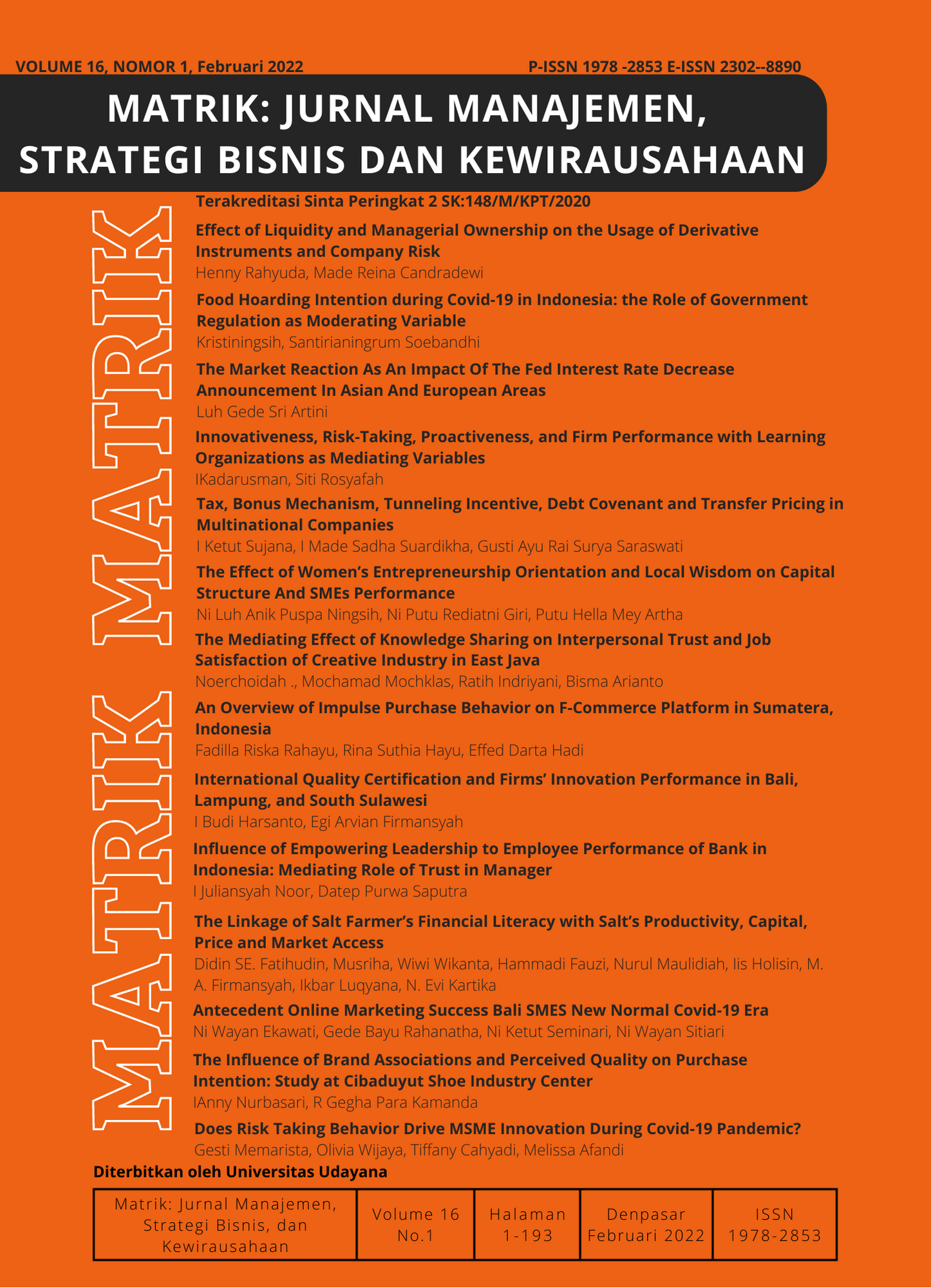Effect of Liquidity and Managerial Ownership on the Usage of Derivative Instruments and Company Risk
Abstract
This study aims to analyze the effect of liquidity, managerial ownership and use of derivatives on corporate risk in the Indonesian capital market, specifically manufacturing companies listed on the IDX.. This research was conducted using a quantitative approach. The population in this study are all manufacturing companies listed on the IDX. The sampling technique used was purposive sampling method. The companies included in the sample of this study are manufacturing companies that use derivative instruments and are always listed on the IDX from 2016 to 2018. A total of 12 companies can be used as final samples in this study. Based on the results of regression analysis and mediation test, it can be concluded that the managerial ownership variable has a significant positive effect on the Usage of Derivative Instruments. The variable Usage of Derivative Instruments has a significant negative effect on company risk. The Usage of Derivative Instruments is able to mediate the relationship between managerial ownership and corporate risk
Downloads
References
Beaver, W., Kettler, P., & Scholes, M. (1970). The Association Between Market Determined and Accounting Determined Risk Measures. The Accounting Review, 45(4), 654–682. https://www.jstor.org/stable/244204
Biase, P. di, & D‘Apolito, E. (2012). The Determinants of Systematic Risk in the Italian Banking System: A Cross-Sectional Time Series Analysis. International Journal of Economics and Finance, 4(11), 152–164. https://doi.org/ 10.5539/ijef.v4n11p152
Borokhovich, K. A., Brunarski, K. R., & Simkins, B. J. (2004). Board Composition and Corporate Use Of Interest Rate Derivatives. The Journal of Financial Research, 27(2), 199–216. https://doi.org/10.1111/j.1475-6803.2004.t01-1-00079.x
Brickley, J. A., Lease, R. C., & Smith, C. W. (1988). Ownership structure and voting on antitakeover amendments. Journal of Financial Economics, 20(C), 267–291. https://doi.org/10.1016/0304-405X(88)90047-5
Buckley, P., Clegg, L. J., Cross, A. R., Liu, X., Voss, H., & Zheng, P. (2007). The Determinants of Chinese Outward Foreign Direct Investment. Journal of International Business Studies, 38(4), 499-518. https://link.springer.com/article/10.1057/palgrave.jibs.8400277
Capozza, D. R., & Seguin, P. J. (2003). Inside Ownership, Risk Sharing and Tobin’s q-Ratios: Evidence from REITs. Real Estate Economics, 31(3), 367–404. https://doi.org/10.1111/1540-6229.00070
Carter, D.A., Sinkey Jr, J. F. (1998). The Use of Interest Rate Derivatives by End-users: The Case of Large Community Banks. Journal of Financial Services Research, 14, 17–34 https://doi.org/10.1023/A:1008057418368
Chen, C. R., Steiner, T. L., & Whyte, A. M. (1998). Risk-taking behavior and management ownership in depository institutions. Journal of Financial Research, 21(1), 1–16. https://doi.org/10.1111/j.1475-6803.1998.tb00266.x
Chun, L.S., & Ramasamy, M. (1999). Accounting variabel as Determinants of Systematic Risk in Malaysian Common Stocks, Asian Pasific Journal of Management, 6(2), 339-350. https://link.springer.com/article/10.1007%2FBF01733773
Chung, K. H., & Pruitt, S. W. (1994). Simple of Tobin ’ s Approximation q. Venture Capital, 23(3), 70–74. https://doi.org/10.2307/3665623
Daily, C. M., & Dalton, D. A. N. R. (2003). Introduction To Special Topic Forum Corporate Governance: Decades of Dialogue and Data. Academy Oí Management Review, 28(3), 371–382. https://doi.org/10.5465/amr.2003.10196703
Elloumi, F., & Gueyie, J. (2001). Financial Distress and Corporate Governance: an empirical analysis. Corporate Governance, 1(1), 15-23. https://doi.org/10.1108/14720700110389548
Froot, K. A. (1993). Risk Management : Coordinating Corporate Investment and Financing Policies. The Journal of Finance, 48(5), 1629-1658. https://doi.org/10.1111/j.1540-6261.1993.tb05123.x
Gatopoulos, G., & Loubergé, H. (2013). Combined use of foreign debt and currency derivatives under the threat of currency crises: The case of Latin American firms. Journal of International Money and Finance, 35, 54–75. https://doi.org/10.1016/j.jimonfin.2013.01 .004
Ghozali, I. (2011). Aplikasi Analisis Multivariate dengan Program SPSS. Semarang: Universitas Diponegoro.
Guay, W. R. (1999). The impact of derivatives on firm risk: An empirical examination of new derivative users. Journal of Accounting and Economics, 26(1–3), 319–351. https://doi.org/10.1016/S0165-4101(98)00032-9
Gujarati, D.N. (2011). Econometrics By Example. New York: Palgrave Macmillan.
Hair Jr, J.F., Hult, G.T. M., Ringle, C. M., & Sarstedt, M. (2014). A Primer on Partial Least Squares Structural Equation Modeling (PLS-SEM). Thousand Oaks: SAGE Publication, Inc.
Hanafi, M. (2014). Manajemen Risiko.Yogyakarta: UPP STIM YKPN.
Hardwick, P., & Adams, M. (1999). The determinants of financial derivatives use in the United Kingdom life insurance industry. Abacus, 35(2), 163–184. https://doi.org/10.1111/1467-6281.00039
Horne, J. C. V., & Warchowicz, J. M. (2008). Fundamentals of Financial Management. England: Pearson Education Limited.
Hull, J. (2009). Options, Futures, and other Derivatives. USA: Pearson Education, Inc.
Jensen, M. C., & Murphy, K. J. (1990). Performance Pay and Top-Management Incentives. Journal of Political Economy, 98(2), 225-264. https://www.jstor.org/stable/2937665
Lantara, I. W. (2010). A Survey on the Use of Derivatives in Indonesia. Gajah Mada International Journal of Business, 12(3), 295–323. https://doi.org/10.22146/gamaijb.5504
McDonald, R. . (2006). Derivatives Markets. USA: Pearson Education, Inc.
Modigliani, F., & Miller, M. H. (1963). Income Taxes and the Cost of Capital. The American Economic Review, 53(3), 433–443. https://www.jstor.org/stable/1809167
Osuoha J. (2013). Financial Engineering, Corporate Governance and Nigeria Economic Development. Journal of Financial Risk Management, 2(4), 61-66. https://doi.org/ 10.4236/jfrm.2013.24010
Salhi, B., & Boujelbene, Y. (2012). Students and Entrepreneurship: Effect of the Training. Journal of Research in Educational Sciences, (3)5, 19-34. https://www.ceeol.com/search/article-detail?id=33741.
Saunders, A., & Cornett, M. (2014). Financial Institution Management/ : A Risk Management Approach. New York: Mc Graw Hill.
Saunders, M., Lewis, P., & Thornhil, A. (2016). Research Methods for Business Students. Italy: Pearson Education
Smith, C. W., & Stulz, R. M. (1985). The Determinants of Firms’ Hedging Policies. Journal of Financial and Quantitative Analysis, 20(4), 391-405. https://doi.org/10.2307/2330757
Sugiyono. (2017). Metode Penelitian Kuantitatif, Kualitatif dan R&D. Bandung: Alfabeta.
Tufano, P. (1996), Who Manages Risk? An Empirical Examination of Risk Management Practices in the Gold Mining Industry. The Journal of Finance, 51, 1097-1137. https://doi.org/10.1111/j.1540-6261.1996.tb04064.x
 This work is licensed under a Creative Commons Attribution-ShareAlike 4.0 International License.
This work is licensed under a Creative Commons Attribution-ShareAlike 4.0 International License.

















